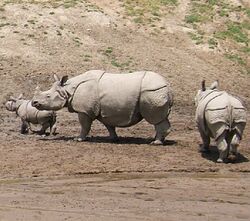Biology:Rhinoceros (genus)
| Rhinoceros | |
|---|---|

| |
| Indian rhinoceros (R. unicornis) | |
| Scientific classification | |
| Domain: | Eukaryota |
| Kingdom: | Animalia |
| Phylum: | Chordata |
| Class: | Mammalia |
| Order: | Perissodactyla |
| Family: | Rhinocerotidae |
| Tribe: | Rhinocerotini |
| Genus: | Rhinoceros Linnaeus, 1758 |
| Type species | |
| Rhinoceros unicornis Linnaeus, 1758
| |
| Species | |
Rhinoceros is a genus comprising one-horned rhinoceroses. This scientific name was proposed by Swedish taxonomist Carl Linnaeus in 1758.[1] The genus contains two species, the Indian rhinoceros (Rhinoceros unicornis) and the Javan rhinoceros (Rhinoceros sondaicus). Although both members are threatened, the Javan rhinoceros is one of the most endangered large mammals in the world with only 60 individuals surviving in Java (Indonesia). The word 'rhinoceros' is of Greek origin meaning "nose-horn".[clarification needed]
Classification
The genus Rhinoceros comprises:
- Indian rhinoceros (R. unicornis) Linnaeus, 1758[1] Indian subcontinent
- Javan rhinoceros (R. sondaicus) Desmarest, 1822[2] Southeast Asia
- †R. sivalensis Falconer and Cautley, 1846 northern Indian subcontinent (Siwalik Hills) Pliocene-Early Pleistocene
- †R. platyrhinus Falconer and Cautley 1847 syn Punjabitherium Khan (1971) Upper Siwaliks, Indian subcontinent, Early Pleistocene to early Middle Pleistocene, India. Largest species in the genus.[3]
- †R. sinensis Owen, 1870[4] Has been used as a wastebasket taxon[5] used to refer to rhinoceros material from the Pleistocene of China, with various specimens belong to other Rhinoceros species, Dicerorhinus and Stephanorhinus,[6] though it is possible that some remains attributed to Rhinoceros sinensis represents a valid and distinct species of Rhinoceros.[3]
The species "Rhinoceros" philippinensis from the early Middle Pleistocene of the Philippines and "Rhinoceros" sinensis hayasakai from the Early-Middle Pleistocene of Taiwan have been transferred to Nesorhinus, which appears to be closely related to Rhinoceros.[7] While Rhinoceros fusuiensis Yan et al. 2014[8] from the Early Pleistocene of South China has been transferred to Dicerorhinus.[7][9]
Etymology
The genus name Rhinoceros is a combination of the ancient Greek words ῥίς (rhis) meaning 'nose' and κέρας (keras) meaning 'horn of an animal'.[10][11]
References
- ↑ 1.0 1.1 Linnæus, C. (1758). [60,%22view%22:%22info%22} "Rhinoceros unicornis"]. Caroli Linnæi Systema naturæ per regna tria naturæ, secundum classes, ordines, genera, species, cum characteribus, differentiis, synonymis, locis. Holmiae: Salvius. p. 56. https://gdz.sub.uni-goettingen.de/id/PPN362053006?tify={%22pages%22:[60],%22view%22:%22info%22}.
- ↑ Desmarest, A. G. (1822). "Rhinocéros des Îles de La Sonde". Mammalogie, ou, Description des espèces de mammifères. 2. Paris: Mme Agasse. pp. 399–400. https://archive.org/details/mammalogieoudesc02desm/page/399.
- ↑ 3.0 3.1 Pandolfi, Luca; Maiorino, Leonardo (2016-02-06). "Reassessment of the largest Pleistocene rhinocerotine Rhinoceros platyrhinus (Mammalia, Rhinocerotidae) from the Upper Siwaliks (Siwalik Hills, India)". Journal of Vertebrate Paleontology 36 (2): e1071266. doi:10.1080/02724634.2015.1071266. ISSN 0272-4634. Bibcode: 2016JVPal..36E1266P. http://www.rhinoresourcecenter.com/pdf_files/148/1489041174.pdf.
- ↑ Schepartz, L. A.; Miller-Antonio, S. (2010). "Taphonomy, life history, and human exploitation of Rhinoceros sinensis at the Middle Pleistocene site of Panxian Dadong, Guizhou, China". International Journal of Osteoarchaeology 20 (3): 253–268. doi:10.1002/oa.1025.
- ↑ Antoine, Pierre-Olivier (March 2012). "Pleistocene and Holocene rhinocerotids (Mammalia, Perissodactyla) from the Indochinese Peninsula" (in en). Comptes Rendus Palevol 11 (2–3): 159–168. doi:10.1016/j.crpv.2011.03.002. Bibcode: 2012CRPal..11..159A.
- ↑ Tong, Hao-wen (November 2012). "Evolution of the non-Coelodonta dicerorhine lineage in China" (in en). Comptes Rendus Palevol 11 (8): 555–562. doi:10.1016/j.crpv.2012.06.002. Bibcode: 2012CRPal..11..555T.
- ↑ 7.0 7.1 Antoine, P.-O.; Reyes, M. C.; Amano, N.; Bautista, A. P.; Chang, C.-H.; Claude, J.; De Vos, J.; Ingicco, T. (2021). "A new rhinoceros clade from the Pleistocene of Asia sheds light on mammal dispersals to the Philippines". Zoological Journal of the Linnean Society 194 (2): 416–430. doi:10.1093/zoolinnean/zlab009.
- ↑ Yan, Yaling; Wang, Yuan; Jin, Changzhu; Mead, Jim I. (December 2014). "New remains of Rhinoceros (Rhinocerotidae, Perissodactyla, Mammalia) associated with Gigantopithecus blacki from the Early Pleistocene Yanliang Cave, Fusui, South China" (in en). Quaternary International 354: 110–121. doi:10.1016/j.quaint.2014.01.004. Bibcode: 2014QuInt.354..110Y. https://linkinghub.elsevier.com/retrieve/pii/S1040618214000135.
- ↑ Pandolfi, Luca (2023-01-19). "Reassessing the phylogeny of Quaternary Eurasian Rhinocerotidae" (in en). Journal of Quaternary Science 38 (3): 291–294. doi:10.1002/jqs.3496. ISSN 0267-8179. Bibcode: 2023JQS....38..291P. https://onlinelibrary.wiley.com/doi/10.1002/jqs.3496.
- ↑ Liddell, H. G.; Scott, R. (1940). "ῥίς". A Greek-English Lexicon (Revised and augmented ed.). Oxford: Clarendon Press. https://www.perseus.tufts.edu/hopper/text?doc=Perseus%3Atext%3A1999.04.0057%3Aentry%3Dr(i%2Fs.
- ↑ Liddell, H. G.; Scott, R. (1940). "κέρᾳ". A Greek-English Lexicon (Revised and augmented ed.). Oxford: Clarendon Press. https://www.perseus.tufts.edu/hopper/text?doc=Perseus%3Atext%3A1999.04.0057%3Aentry%3Dke%2Fras.
External links
| Wikimedia Commons has media related to Rhinoceros. |
Wikidata ☰ Q134657 entry
 |

